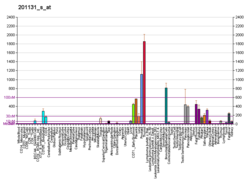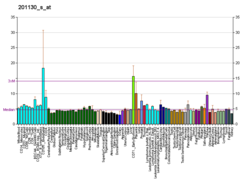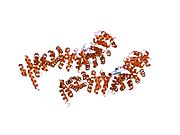CDH1(gene)
CDH1 (gene)CAM 120/80 또는 상피 캐더린(E-cadherin) 또는 우보무린(Uvomorulin)이라고도 알려진 Cadherin-1(APC/C 활성제 단백질 CDH1)은 인간에서 CDH1 유전자에 의해 인코딩되는 단백질이다.[5]돌연변이는 위암, 유방암, 대장암, 갑상선암, 난소암과 상관관계가 있다.CDH1도 CD324(분화 324 클러스터)로 지정되었다.그것은 종양 억제 유전자다.[6][7]
함수
캐더린-1은 캐더린 슈퍼 패밀리의 클래식 멤버다.인코딩된 단백질은 세포외 접착 당코프로틴으로 5개의 세포외 캐더린 반복, 투과성 영역, 보존도가 높은 세포질 꼬리로 구성된 칼슘 의존성 세포유착 당코프로틴이다.이 유전자의 돌연변이는 위암, 유방암, 대장암, 갑상선암, 난소암과 상관관계가 있다.기능 상실은 증식, 침입 및/또는 전이를 증가시킴으로써 암의 진행에 기여하는 것으로 생각된다.이 단백질의 엑토도메인은 포유류 세포에 대한 박테리아 유착을 매개하며, 세포질 영역은 내장을 위해 필요하다.확인된 대본 변형은 합의된 이중 현장에서 돌연변이로 인해 발생한다.[8]
E-cadherin(에피델리알)은 캐더린 계열의 가장 학문이 좋은 구성원이다.세포외 영역의 5개의 캐더린 반복(EC1 ~ EC5)과 1개의 트랜섬브레인 도메인, p120-카테닌과 베타-카테닌을 결합하는 세포내 도메인으로 구성된다.세포내 영역은 베타-카테닌 결합과 따라서 E-카데린 기능에 필수적인 고인산화 영역을 포함한다.[citation needed]베타 카테닌은 알파 카테닌과도 결합할 수 있다.알파-카테닌은 액틴 함유 세포골격 필라멘트 규제에 참여한다.상피세포에서 E-캐더린 함유 세포-세포 접합부는 종종 세포골격의 작용성 필라멘트에 인접한다.
E-cadherin은 포유류 발달의 2세포 단계에서 먼저 발현되며, 8세포 단계에 의해 인산염화되며, 여기에서 콤프레션을 일으킨다.[citation needed]성인 조직에서 E-cadherin은 상피 조직으로 표현되며, 세포 표면에서 5시간 반의 수명을 가지고 끊임없이 재생된다.[citation needed]E-cadherin에 의해 매개되는 세포-세포 상호작용은 많은 동물에서 바스큘라 형성에 중요하다.[9]
임상적 유의성

E-cadherin 기능이나 표현의 상실은 암 진행과 전이에 관련되어 있다.[10][11]E-cadherin 하향 조정은 조직 내 세포 접착 강도를 감소시켜 세포 운동성의 증가를 초래한다.이것은 차례로 암세포가 지하막을 건너 주변 조직을 침범하게 할 수 있다.[11]E-cadherin은 또한 다른 종류의 유방암을 진단하는데 병리학자들이 사용한다.침습성 덕트암과 비교했을 때, E-cadherin 발현이 면역화학에 의해 연구될 때 침습성 로브암 대다수에 현저하게 감소하거나 존재하지 않는다.[12]두개골 발달에서 두개 봉합 융접 시 E-cadherin과 N-cadherin 시간공간 표현은 엄격하게 규제된다.[13]
상호작용
CDH1(gene)과 상호 작용하는 것으로 나타났다.
암
전이
상피와 중피 사이의 전환은 배아 발달과 암 전이에서 중요한 역할을 한다.EMT(Epitelial-meschymal transition)와 MET(Mesenchymal-Epithelimal transition)의 E-cadherin 수준 변화E-cadherin은 침습성 전엽 유방암에서 침습 억제기와 고전적인 종양 억제 유전자의 역할을 한다.[41]
EMT
E-cadherin은 상피 세포를 단단하게 고정시키는 세포-세포 접착의 중요한 유형이다.E-cadherin은 E-cadherin의 세포질 꼬리에 의해 세포막의 β-catenin을 분리할 수 있다.E-cadherin 식이 손실되면 세포질 속으로 β-catenin이 방출된다.해방된 β-카테닌 분자는 핵으로 이동하며 EMT 유도 전사 인자의 발현을 유발할 수 있다.구성적 RTK 활성화와 같은 다른 메커니즘과 함께, E-cadherin 상실은 암세포를 중피 상태로 이끌고 전이를 겪을 수 있다.E-cadherin은 EMT에서 중요한 스위치다.[41]
만났다
중피주 암세포는 새로운 부위로 이동하며 어떤 유리한 미세환경에서 MET를 겪을 수 있다.예를 들어 암세포는 새로운 부위에서 차별화된 상피세포 특징을 인식하고 E-카데린 발현을 상향 조절할 수 있다.그 암세포들은 세포-세포 접착제를 다시 형성하여 상피 상태로 돌아올 수 있다.[41]
예
- CDH1에서 유전된 불활성화 돌연변이는 유전성 확산 위암과 관련이 있다.이 질환을 가진 개인은 평생 확산 위암에 걸릴 위험이 70%에 달하며, CDH1 돌연변이를 가진 암컷은 평생엽 유방암에 걸릴 위험이 60%에 이른다.[42]
- Lobular 유방암의 56%에서 CDH1 불활성화(야생성 알레르기가 손실된 회사)[43][44]
- 확산 위암의 50%에서 CDH1 불활성화.[45]
- 입자 유방암 84%[46]에서 E-카데린 단백질 발현 완전 손실
유전적 및 후생적 제어
SNAI1/SNAIL,[47][48] ZFHX1B/SIP1,[49] SNAI2/SLUG,[50][51] TWIND1[52], DeltaEF1[53] 등 여러 단백질이 E-cadherin 식을 다운규제하는 것으로 밝혀졌다.이러한 전사 인자의 표현이 변경될 때, E-cadherin의 전사적 억제기는 종양 세포에서 과압되었다.[47][48][49][50][52][53]또 다른 유전자 그룹인 AML1, p300, HNF3는 E-cadherin의 발현을 조절할 수 있다.[54][55]
E-cadherin의 후생유전적 조절을 연구하기 위해 M Lombaerts 외 연구진은 27개의 인간 유방 세포 라인에 대해 게놈 넓은 표현 연구를 수행했다.그들의 결과는 각각 섬유성이나 상피성 표현형을 가진 두 개의 주요 성단을 보여주었다.정밀 검사에서 섬유블라스트 표현형을 보이는 군집은 부분 또는 전체 CDH1 프로모터 메틸레이션만 가지고 있으며, 상피 표현형을 가진 군집은 야생형 세포선과 돌연변이 CDH1 상태를 가진 세포라인을 모두 가지고 있다.저자들은 또한 EMT는 CDH1 프로모터의 하이퍼메틸화로 유방암 세포 라인에서 일어날 수 있지만, CDH1 돌연변이 EMT를 가진 유방암 세포 라인에서는 일어날 수 없다는 것을 발견했다.E-cadherin 상실이 EMT의 초기 또는 주요 원인이라는 가설과 배치된다. 결론적으로, 결과는 "E-cadherin 전사 불활성화는 에피-페노멘온이며 전체 프로그램의 일부로서 E-cadherin 표현의 손실보다 훨씬 더 심각한 영향을 미친다"[55]고 제안한다.
다른 연구들은 또한 E-cadherin 표현에 대한 후생유전학적 조절이 전이 중에 발생한다는 것을 보여준다.E-cadherin 5' CpG섬의 메틸레이션 패턴은 안정적이지 않다.상피종양의 많은 사례들의 전이적 진행 중에, E-cadherin의 일시적인 손실이 관찰되고 E-cadherin 표현식의 이질적인 상실은 E-cadherin의 촉진자 지역 메틸화의 이질적인 패턴에서 비롯된다.[56]
참고 항목
참조
- ^ a b c GRCh38: 앙상블 릴리스 89: ENSG000039068 - 앙상블, 2017년 5월
- ^ a b c GRCm38: 앙상블 릴리스 89: ENSMUSG00000000303 - 앙상블, 2017년 5월
- ^ "Human PubMed Reference:". National Center for Biotechnology Information, U.S. National Library of Medicine.
- ^ "Mouse PubMed Reference:". National Center for Biotechnology Information, U.S. National Library of Medicine.
- ^ Huntsman DG, Caldas C (Mar 1999). "Assignment1 of the E-cadherin gene (CDH1) to chromosome 16q22.1 by radiation hybrid mapping". Cytogenetics and Cell Genetics. 83 (1–2): 82–3. doi:10.1159/000015134. PMID 9925936. S2CID 39971762.
- ^ Semb H, Christofori G (December 1998). "The tumor-suppressor function of E-cadherin". American Journal of Human Genetics. 63 (6): 1588–93. doi:10.1086/302173. PMC 1377629. PMID 9837810.
- ^ Wong AS, Gumbiner BM (June 2003). "Adhesion-independent mechanism for suppression of tumor cell invasion by E-cadherin". The Journal of Cell Biology. 161 (6): 1191–203. doi:10.1083/jcb.200212033. PMC 2173007. PMID 12810698.
- ^ "Entrez Gene: CDH1 cadherin 1, type 1, E-cadherin (epithelial)".
- ^ Fleming TP, Papenbrock T, Fesenko I, Hausen P, Sheth B (August 2000). "Assembly of tight junctions during early vertebrate development". Seminars in Cell & Developmental Biology. 11 (4): 291–9. doi:10.1006/scdb.2000.0179. PMID 10966863.
- ^ Beavon IR (August 2000). "The E-cadherin-catenin complex in tumour metastasis: structure, function and regulation". European Journal of Cancer. 36 (13 Spec No): 1607–20. doi:10.1016/S0959-8049(00)00158-1. PMID 10959047.
- ^ a b Weinberg, Robert (2006). The Biology of Cancer. Garland Science. pp. 864 pages. ISBN 9780815340782. Archived from the original on 2015-09-11. Retrieved 2012-05-06.
- ^ 로젠, P. 로젠의 유방병리학, 2009년 3월 3일, 페이지 704.리핀콧 윌리엄스 & 윌킨스
- ^ 사하르 드, 베흐르 B, 퐁 KD, 롱게커 MT, 쿼토 N.후전두 두개골 봉합 및 폐쇄 시 캐더린 표현 패턴의 고유 변조.세포 조직 기관.2010;191(5):401-13. doi:10.1159/000272318.Epub 2009년 12월 24일.PMID 20051668; PMCID: PMC2859230.
- ^ Fujita Y, Krause G, Scheffner M, Zechner D, Leddy HE, Behrens J, Sommer T, Birchmeier W (March 2002). "Hakai, a c-Cbl-like protein, ubiquitinates and induces endocytosis of the E-cadherin complex". Nature Cell Biology. 4 (3): 222–31. doi:10.1038/ncb758. PMID 11836526. S2CID 40423770.
- ^ Vodermaier HC, Gieffers C, Maurer-Stroh S, Eisenhaber F, Peters JM (September 2003). "TPR subunits of the anaphase-promoting complex mediate binding to the activator protein CDH1". Current Biology. 13 (17): 1459–68. doi:10.1016/S0960-9822(03)00581-5. PMID 12956947. S2CID 5942532.
- ^ a b Kang JS, Feinleib JL, Knox S, Ketteringham MA, Krauss RS (April 2003). "Promyogenic members of the Ig and cadherin families associate to positively regulate differentiation". Proceedings of the National Academy of Sciences of the United States of America. 100 (7): 3989–94. Bibcode:2003PNAS..100.3989K. doi:10.1073/pnas.0736565100. PMC 153035. PMID 12634428.
- ^ Klingelhöfer J, Troyanovsky RB, Laur OY, Troyanovsky S (August 2000). "Amino-terminal domain of classic cadherins determines the specificity of the adhesive interactions". Journal of Cell Science. 113 (16): 2829–36. doi:10.1242/jcs.113.16.2829. PMID 10910767.
- ^ Davies G, Jiang WG, Mason MD (April 2001). "HGF/SF modifies the interaction between its receptor c-Met, and the E-cadherin/catenin complex in prostate cancer cells". International Journal of Molecular Medicine. 7 (4): 385–8. doi:10.3892/ijmm.7.4.385. PMID 11254878.
- ^ Daniel JM, Reynolds AB (September 1995). "The tyrosine kinase substrate p120cas binds directly to E-cadherin but not to the adenomatous polyposis coli protein or alpha-catenin". Molecular and Cellular Biology. 15 (9): 4819–24. doi:10.1128/mcb.15.9.4819. PMC 230726. PMID 7651399.
- ^ Ireton RC, Davis MA, van Hengel J, Mariner DJ, Barnes K, Thoreson MA, et al. (November 2002). "A novel role for p120 catenin in E-cadherin function". The Journal of Cell Biology. 159 (3): 465–76. doi:10.1083/jcb.200205115. PMC 2173073. PMID 12427869.
- ^ Bonné S, Gilbert B, Hatzfeld M, Chen X, Green KJ, van Roy F (April 2003). "Defining desmosomal plakophilin-3 interactions". The Journal of Cell Biology. 161 (2): 403–16. doi:10.1083/jcb.200303036. PMC 2172904. PMID 12707304.
- ^ a b c Hazan RB, Norton L (April 1998). "The epidermal growth factor receptor modulates the interaction of E-cadherin with the actin cytoskeleton". The Journal of Biological Chemistry. 273 (15): 9078–84. doi:10.1074/jbc.273.15.9078. PMID 9535896.
- ^ Kucerová D, Sloncová E, Tuhácková Z, Vojtechová M, Sovová V (December 2001). "Expression and interaction of different catenins in colorectal carcinoma cells". International Journal of Molecular Medicine. 8 (6): 695–8. doi:10.3892/ijmm.8.6.695. PMID 11712088.
- ^ Oyama T, Kanai Y, Ochiai A, Akimoto S, Oda T, Yanagihara K, Nagafuchi A, Tsukita S, Shibamoto S, Ito F (December 1994). "A truncated beta-catenin disrupts the interaction between E-cadherin and alpha-catenin: a cause of loss of intercellular adhesiveness in human cancer cell lines". Cancer Research. 54 (23): 6282–7. PMID 7954478.
- ^ Takahashi K, Suzuki K, Tsukatani Y (July 1997). "Induction of tyrosine phosphorylation and association of beta-catenin with EGF receptor upon tryptic digestion of quiescent cells at confluence". Oncogene. 15 (1): 71–8. doi:10.1038/sj.onc.1201160. PMID 9233779.
- ^ Kinch MS, Clark GJ, Der CJ, Burridge K (July 1995). "Tyrosine phosphorylation regulates the adhesions of ras-transformed breast epithelia". The Journal of Cell Biology. 130 (2): 461–71. doi:10.1083/jcb.130.2.461. PMC 2199929. PMID 7542250.
- ^ Navarro P, Lozano E, Cano A (August 1993). "Expression of E- or P-cadherin is not sufficient to modify the morphology and the tumorigenic behavior of murine spindle carcinoma cells. Possible involvement of plakoglobin". Journal of Cell Science. 105 (4): 923–34. doi:10.1242/jcs.105.4.923. hdl:10261/78716. PMID 8227214.
- ^ Schmeiser K, Grand RJ (April 1999). "The fate of E- and P-cadherin during the early stages of apoptosis". Cell Death and Differentiation. 6 (4): 377–86. doi:10.1038/sj.cdd.4400504. PMID 10381631.
- ^ Laoukili J, Alvarez-Fernandez M, Stahl M, Medema RH (September 2008). "FoxM1 is degraded at mitotic exit in a Cdh1-dependent manner". Cell Cycle. 7 (17): 2720–6. doi:10.4161/cc.7.17.6580. PMID 18758239.
- ^ a b Yoon YM, Baek KH, Jeong SJ, Shin HJ, Ha GH, Jeon AH, Hwang SG, Chun JS, Lee CW (September 2004). "WD repeat-containing mitotic checkpoint proteins act as transcriptional repressors during interphase". FEBS Letters. 575 (1–3): 23–9. doi:10.1016/j.febslet.2004.07.089. PMID 15388328. S2CID 21762011.
- ^ Li Z, Kim SH, Higgins JM, Brenner MB, Sacks DB (December 1999). "IQGAP1 and calmodulin modulate E-cadherin function". The Journal of Biological Chemistry. 274 (53): 37885–92. doi:10.1074/jbc.274.53.37885. PMID 10608854.
- ^ Piedra J, Miravet S, Castaño J, Pálmer HG, Heisterkamp N, García de Herreros A, Duñach M (April 2003). "p120 Catenin-associated Fer and Fyn tyrosine kinases regulate beta-catenin Tyr-142 phosphorylation and beta-catenin-alpha-catenin Interaction". Molecular and Cellular Biology. 23 (7): 2287–97. doi:10.1128/MCB.23.7.2287-2297.2003. PMC 150740. PMID 12640114.
- ^ Nourry C, Maksumova L, Pang M, Liu X, Wang T (May 2004). "Direct interaction between Smad3, APC10, CDH1 and HEF1 in proteasomal degradation of HEF1". BMC Cell Biology. 5 (1): 20. doi:10.1186/1471-2121-5-20. PMC 420458. PMID 15144564.
- ^ Shibata T, Gotoh M, Ochiai A, Hirohashi S (August 1994). "Association of plakoglobin with APC, a tumor suppressor gene product, and its regulation by tyrosine phosphorylation". Biochemical and Biophysical Research Communications. 203 (1): 519–22. doi:10.1006/bbrc.1994.2213. PMID 8074697.
- ^ Hinck L, Näthke IS, Papkoff J, Nelson WJ (June 1994). "Dynamics of cadherin/catenin complex formation: novel protein interactions and pathways of complex assembly". The Journal of Cell Biology. 125 (6): 1327–40. doi:10.1083/jcb.125.6.1327. PMC 2290923. PMID 8207061.
- ^ Knudsen KA, Wheelock MJ (August 1992). "Plakoglobin, or an 83-kD homologue distinct from beta-catenin, interacts with E-cadherin and N-cadherin". The Journal of Cell Biology. 118 (3): 671–9. doi:10.1083/jcb.118.3.671. PMC 2289540. PMID 1639850.
- ^ Hazan RB, Kang L, Roe S, Borgen PI, Rimm DL (December 1997). "Vinculin is associated with the E-cadherin adhesion complex". The Journal of Biological Chemistry. 272 (51): 32448–53. doi:10.1074/jbc.272.51.32448. PMID 9405455.
- ^ Brady-Kalnay SM, Rimm DL, Tonks NK (August 1995). "Receptor protein tyrosine phosphatase PTPmu associates with cadherins and catenins in vivo". The Journal of Cell Biology. 130 (4): 977–86. doi:10.1083/jcb.130.4.977. PMC 2199947. PMID 7642713.
- ^ Brady-Kalnay SM, Mourton T, Nixon JP, Pietz GE, Kinch M, Chen H, Brackenbury R, Rimm DL, Del Vecchio RL, Tonks NK (April 1998). "Dynamic interaction of PTPmu with multiple cadherins in vivo". The Journal of Cell Biology. 141 (1): 287–96. doi:10.1083/jcb.141.1.287. PMC 2132733. PMID 9531566.
- ^ Besco JA, Hooft van Huijsduijnen R, Frostholm A, Rotter A (October 2006). "Intracellular substrates of brain-enriched receptor protein tyrosine phosphatase rho (RPTPrho/PTPRT)". Brain Research. 1116 (1): 50–7. doi:10.1016/j.brainres.2006.07.122. PMID 16973135. S2CID 23343123.
- ^ a b c Polyak K, Weinberg RA (April 2009). "Transitions between epithelial and mesenchymal states: acquisition of malignant and stem cell traits". Nature Reviews. Cancer. 9 (4): 265–73. doi:10.1038/nrc2620. PMID 19262571. S2CID 3336730.
- ^ van der Post RS, Vogelaar IP, Carneiro F, Guilford P, Huntsman D, Hoogerbrugge N, et al. (June 2015). "Hereditary diffuse gastric cancer: updated clinical guidelines with an emphasis on germline CDH1 mutation carriers". Journal of Medical Genetics. 52 (6): 361–74. doi:10.1136/jmedgenet-2015-103094. PMC 4453626. PMID 25979631.
- ^ Berx G, Cleton-Jansen AM, Nollet F, de Leeuw WJ, van de Vijver M, Cornelisse C, van Roy F (December 1995). "E-cadherin is a tumour/invasion suppressor gene mutated in human lobular breast cancers". The EMBO Journal. 14 (24): 6107–15. doi:10.1002/j.1460-2075.1995.tb00301.x. PMC 394735. PMID 8557030.
- ^ Berx G, Cleton-Jansen AM, Strumane K, de Leeuw WJ, Nollet F, van Roy F, Cornelisse C (November 1996). "E-cadherin is inactivated in a majority of invasive human lobular breast cancers by truncation mutations throughout its extracellular domain". Oncogene. 13 (9): 1919–25. PMID 8934538.
- ^ Becker KF, Atkinson MJ, Reich U, Becker I, Nekarda H, Siewert JR, Höfler H (July 1994). "E-cadherin gene mutations provide clues to diffuse type gastric carcinomas". Cancer Research. 54 (14): 3845–52. PMID 8033105.
- ^ De Leeuw WJ, Berx G, Vos CB, Peterse JL, Van de Vijver MJ, Litvinov S, et al. (December 1997). "Simultaneous loss of E-cadherin and catenins in invasive lobular breast cancer and lobular carcinoma in situ". The Journal of Pathology. 183 (4): 404–11. doi:10.1002/(SICI)1096-9896(199712)183:4<404::AID-PATH1148>3.0.CO;2-9. PMID 9496256.
- ^ a b Batlle E, Sancho E, Francí C, Domínguez D, Monfar M, Baulida J, García De Herreros A (February 2000). "The transcription factor snail is a repressor of E-cadherin gene expression in epithelial tumour cells". Nature Cell Biology. 2 (2): 84–9. doi:10.1038/35000034. PMID 10655587. S2CID 23809509.
- ^ a b Cano A, Pérez-Moreno MA, Rodrigo I, Locascio A, Blanco MJ, del Barrio MG, Portillo F, Nieto MA (February 2000). "The transcription factor snail controls epithelial-mesenchymal transitions by repressing E-cadherin expression". Nature Cell Biology. 2 (2): 76–83. doi:10.1038/35000025. hdl:10261/32314. PMID 10655586. S2CID 28329186.
- ^ a b Comijn J, Berx G, Vermassen P, Verschueren K, van Grunsven L, Bruyneel E, et al. (June 2001). "The two-handed E box binding zinc finger protein SIP1 downregulates E-cadherin and induces invasion". Molecular Cell. 7 (6): 1267–78. doi:10.1016/S1097-2765(01)00260-X. PMID 11430829.
- ^ a b Hajra KM, Chen DY, Fearon ER (March 2002). "The SLUG zinc-finger protein represses E-cadherin in breast cancer". Cancer Research. 62 (6): 1613–8. PMID 11912130.
- ^ De Craene B, Gilbert B, Stove C, Bruyneel E, van Roy F, Berx G (July 2005). "The transcription factor snail induces tumor cell invasion through modulation of the epithelial cell differentiation program". Cancer Research. 65 (14): 6237–44. doi:10.1158/0008-5472.CAN-04-3545. PMID 16024625.
- ^ a b Yang J, Mani SA, Donaher JL, Ramaswamy S, Itzykson RA, Come C, Savagner P, Gitelman I, Richardson A, Weinberg RA (June 2004). "Twist, a master regulator of morphogenesis, plays an essential role in tumor metastasis". Cell. 117 (7): 927–39. doi:10.1016/j.cell.2004.06.006. PMID 15210113. S2CID 16181905.
- ^ a b Eger A, Aigner K, Sonderegger S, Dampier B, Oehler S, Schreiber M, Berx G, Cano A, Beug H, Foisner R (March 2005). "DeltaEF1 is a transcriptional repressor of E-cadherin and regulates epithelial plasticity in breast cancer cells". Oncogene. 24 (14): 2375–85. doi:10.1038/sj.onc.1208429. PMID 15674322.
- ^ Liu YN, Lee WW, Wang CY, Chao TH, Chen Y, Chen JH (December 2005). "Regulatory mechanisms controlling human E-cadherin gene expression". Oncogene. 24 (56): 8277–90. doi:10.1038/sj.onc.1208991. PMID 16116478.
- ^ a b Lombaerts M, van Wezel T, Philippo K, Dierssen JW, Zimmerman RM, Oosting J, van Eijk R, Eilers PH, van de Water B, Cornelisse CJ, Cleton-Jansen AM (March 2006). "E-cadherin transcriptional downregulation by promoter methylation but not mutation is related to epithelial-to-mesenchymal transition in breast cancer cell lines". British Journal of Cancer. 94 (5): 661–71. doi:10.1038/sj.bjc.6602996. PMC 2361216. PMID 16495925.
- ^ Graff JR, Gabrielson E, Fujii H, Baylin SB, Herman JG (January 2000). "Methylation patterns of the E-cadherin 5' CpG island are unstable and reflect the dynamic, heterogeneous loss of E-cadherin expression during metastatic progression". The Journal of Biological Chemistry. 275 (4): 2727–32. doi:10.1074/jbc.275.4.2727. PMID 10644736.
추가 읽기
- Berx G, Becker KF, Höfler H, van Roy F (1998). "Mutations of the human E-cadherin (CDH1) gene". Human Mutation. 12 (4): 226–37. doi:10.1002/(SICI)1098-1004(1998)12:4<226::AID-HUMU2>3.0.CO;2-D. PMID 9744472.
- Wijnhoven BP, Dinjens WN, Pignatelli M (August 2000). "E-cadherin-catenin cell–cell adhesion complex and human cancer". The British Journal of Surgery. 87 (8): 992–1005. doi:10.1046/j.1365-2168.2000.01513.x. hdl:1765/56571. PMID 10931041. S2CID 3083613.
- Beavon IR (August 2000). "The E-cadherin-catenin complex in tumour metastasis: structure, function and regulation". European Journal of Cancer. 36 (13 Spec No): 1607–20. doi:10.1016/S0959-8049(00)00158-1. PMID 10959047.
- Wilson PD (April 2001). "Polycystin: new aspects of structure, function, and regulation". Journal of the American Society of Nephrology. 12 (4): 834–45. doi:10.1681/ASN.V124834. PMID 11274246.
- Chun YS, Lindor NM, Smyrk TC, Petersen BT, Burgart LJ, Guilford PJ, Donohue JH (July 2001). "Germline E-cadherin gene mutations: is prophylactic total gastrectomy indicated?". Cancer. 92 (1): 181–7. doi:10.1002/1097-0142(20010701)92:1<181::AID-CNCR1307>3.0.CO;2-J. PMID 11443625.
- Hazan RB, Qiao R, Keren R, Badano I, Suyama K (April 2004). "Cadherin switch in tumor progression". Annals of the New York Academy of Sciences. 1014 (1): 155–63. Bibcode:2004NYASA1014..155H. doi:10.1196/annals.1294.016. PMID 15153430. S2CID 37486403.
- Bryant DM, Stow JL (August 2004). "The ins and outs of E-cadherin trafficking". Trends in Cell Biology. 14 (8): 427–34. doi:10.1016/j.tcb.2004.07.007. PMID 15308209.
- Wang HD, Ren J, Zhang L (November 2004). "CDH1 germline mutation in hereditary gastric carcinoma". World Journal of Gastroenterology. 10 (21): 3088–93. doi:10.3748/wjg.v10.i21.3088. PMC 4611247. PMID 15457549.
- Reynolds AB, Carnahan RH (December 2004). "Regulation of cadherin stability and turnover by p120ctn: implications in disease and cancer". Seminars in Cell & Developmental Biology. 15 (6): 657–63. doi:10.1016/j.semcdb.2004.09.003. PMID 15561585.
- Moran CJ, Joyce M, McAnena OJ (April 2005). "CDH1 associated gastric cancer: a report of a family and review of the literature". European Journal of Surgical Oncology. 31 (3): 259–64. doi:10.1016/j.ejso.2004.12.010. PMID 15780560.
- Georgolios A, Batistatou A, Manolopoulos L, Charalabopoulos K (March 2006). "Role and expression patterns of E-cadherin in head and neck squamous cell carcinoma (HNSCC)". Journal of Experimental & Clinical Cancer Research. 25 (1): 5–14. PMID 16761612.
- Renaud-Young M, Gallin WJ (October 2002). "In the first extracellular domain of E-cadherin, heterophilic interactions, but not the conserved His-Ala-Val motif, are required for adhesion". The Journal of Biological Chemistry. 277 (42): 39609–16. doi:10.1074/jbc.M201256200. PMID 12154084.
외부 링크
- CDH1+단백질,+인간, 미국 국립 의학 도서관의 의학 과목 제목(MesH)
- 유전 확산 위암에 대한 GeneReviews/NCBI/NIH/UW 입력
- UCSC 게놈 브라우저의 인간 CDH1 게놈 위치 및 CDH1 유전자 세부 정보 페이지.
이 기사는 공공영역에 있는 미국 국립 의학 도서관의 텍스트를 통합하고 있다.














